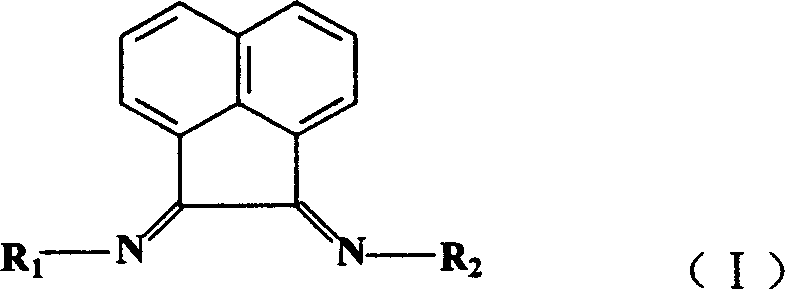Composite catalist of titanium substitued nickle acenaphthene diimine of synthesizing branched polyvinyl and its preparation process
A branched polyethylene and composite catalyst technology is applied in the field of titanium-substituted acenaphthene diimide nickel composite catalyst and its preparation, which can solve the problems of difficulty in promotion and use, irregular product shape, and high cost, and achieves the advantages of being conducive to popularization and use, and achieving remarkable results. The effect of superiority
- Summary
- Abstract
- Description
- Claims
- Application Information
AI Technical Summary
Problems solved by technology
Method used
Image
Examples
Embodiment 1
[0029] 1. Nickel complex NiL 1 Cl 2 Preparation: Under the protection of nitrogen, dissolve 2 grams of anhydrous nickel chloride in 20 ml of absolute ethanol for 2 to 3 hours. 1 30 g CH 2 Cl 2 solution, reflux reaction for 12 to 16 hours, drained to remove the solvent, washed three times with anhydrous ether, and dried in vacuum to obtain the desired substituted acenaphthylenediimide nickel complex NiL 1 Cl 2 .
[0030] 2. Catalyst preparation:
[0031]2-1. Mix 5 g of microspherical SiO 2 Put it in a tube furnace, heat it under nitrogen, raise the temperature to 600°C, calcine and dehydrate at a constant temperature, cool after 6 hours, and discharge under nitrogen protection to obtain 4 grams of SiO 2 , placed in a reaction flask, add 40ml of heptane, under nitrogen protection and constant stirring, add 2.5mol / L AlEt 3 3ml of hexane solution, maintained at 25-30°C for 30 minutes, vacuum-dried to remove heptane, and obtained pretreated SiO 2 .
[0032] 2-2. Add 1.2 g...
Embodiment 2
[0040] In Step 2-4 of Example 1, 1 gram of TiCl 4 Change to 1 g TiCl 4 and 0.5 g Ti(OR 1 ) 4 All the other conditions and operations are the same as in Example One, and the prepared catalyst is polymerized under the same conditions in Example One.
[0041] The density of the obtained branched polyethylene under the above polymerization conditions is 0.901g / cm 3 , is a plastic body with a branching degree of 14.4. The catalytic efficiency of the catalyst is 50 kgLLDPE / mol(Ti+Ni).
Embodiment 3
[0043] In step 1 of Example 1, NiL 1 Cl 2 Change to NiL 2 Cl 2 , L 1 change to L 2 ; In steps 2-5, 1.624g NiL 1 Cl 2 Change to 1.610gNiL 2 Cl 2 , all the other conditions and operations are the same as in Example 1, and the prepared catalyst is polymerized under the same conditions as in Example 1.
[0044] Under the above polymerization conditions, the density of the obtained branched polyethylene is 0.910g / cm 3 , is a plastic body with a branching degree of 11.3. The catalytic efficiency of the catalyst was 53 kg LLDPE / mol(Ti+Ni).
PUM
| Property | Measurement | Unit |
|---|---|---|
| Density | aaaaa | aaaaa |
| Density | aaaaa | aaaaa |
| Density | aaaaa | aaaaa |
Abstract
Description
Claims
Application Information
 Login to View More
Login to View More - R&D
- Intellectual Property
- Life Sciences
- Materials
- Tech Scout
- Unparalleled Data Quality
- Higher Quality Content
- 60% Fewer Hallucinations
Browse by: Latest US Patents, China's latest patents, Technical Efficacy Thesaurus, Application Domain, Technology Topic, Popular Technical Reports.
© 2025 PatSnap. All rights reserved.Legal|Privacy policy|Modern Slavery Act Transparency Statement|Sitemap|About US| Contact US: help@patsnap.com


